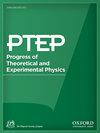用于 J-PARC 中子寿命实验的全装备自旋翻转斩波器的性能
IF 8.3
4区 物理与天体物理
Q1 Physics and Astronomy
引用次数: 0
摘要
为了解决 "中子寿命之谜"(测量方法不同,测得的中子寿命也不同),J-PARC 正在进行脉冲中子束实验。在该实验中,使用自旋翻转斩波器(SFC)将中子束成 40 厘米长,统计灵敏度受到 SFC 孔径大小的限制。SFC 由三组磁性超级反射镜和两个共振自旋翻转器组成。本文讨论了扩大 SFC 孔径的升级方案。通过这次升级,中子寿命实验单位时间内的统计量增加了 2.8 倍,同时信噪比保持在 250-400 之间,与以前相当。因此,中子寿命实验达到 1 秒精度所需的时间从 590 天减少到 170 天,大大缩短了时间。统计量的提高还将有助于减少系统不确定性,如背景评估,从而促进 J-PARC 中子寿命实验的进一步发展。本文章由计算机程序翻译,如有差异,请以英文原文为准。
Performance of the Fully-equipped Spin Flip Chopper For Neutron Lifetime Experiment at J-PARC
To solve the “neutron lifetime puzzle,” where measured neutron lifetimes differ depending on the measurement methods, an experiment with pulsed neutron beam at J-PARC is in progress. In this experiment, neutrons are bunched into 40-cm lengths using a spin flip chopper (SFC), where the statistical sensitivity was limited by the aperture size of the SFC. The SFC comprises three sets of magnetic supermirrors and two resonant spin flippers. In this paper, we discuss an upgrade to enlarge the apertures of the SFC. With this upgrade, the statistics per unit time of the neutron lifetime experiment increased by a factor of 2.8, while maintaining a signal-to-noise ratio of 250–400 comparable to the previous one. Consequently, the time required to reach a precision of 1 s in the neutron lifetime experiment was reduced from 590 to 170 days, which is a significant reduction in time. This improvement in statistic will also contribute to the reduction of systematic uncertainties, such as background evaluation, fostering further advancements in the neutron lifetime experiments at J-PARC.
求助全文
通过发布文献求助,成功后即可免费获取论文全文。
去求助
来源期刊

Progress of Theoretical and Experimental Physics
PHYSICS, MULTIDISCIPLINARY-PHYSICS, PARTICLES & FIELDS
CiteScore
12.00
自引率
5.70%
发文量
148
审稿时长
17 weeks
期刊介绍:
Progress of Theoretical and Experimental Physics (PTEP) is an international journal that publishes articles on theoretical and experimental physics. PTEP is a fully open access, online-only journal published by the Physical Society of Japan.
PTEP is the successor to Progress of Theoretical Physics (PTP), which terminated in December 2012 and merged into PTEP in January 2013.
PTP was founded in 1946 by Hideki Yukawa, the first Japanese Nobel Laureate. PTEP, the successor journal to PTP, has a broader scope than that of PTP covering both theoretical and experimental physics.
PTEP mainly covers areas including particles and fields, nuclear physics, astrophysics and cosmology, beam physics and instrumentation, and general and mathematical physics.
 求助内容:
求助内容: 应助结果提醒方式:
应助结果提醒方式:


